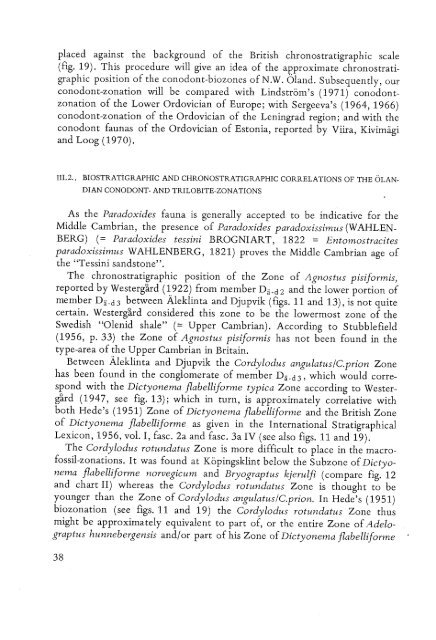UTRECHT MICROPALEONTOLOGICAL BUllETINS
UTRECHT MICROPALEONTOLOGICAL BUllETINS
UTRECHT MICROPALEONTOLOGICAL BUllETINS
You also want an ePaper? Increase the reach of your titles
YUMPU automatically turns print PDFs into web optimized ePapers that Google loves.
placed against the background of the British chronostratigraphic scale<br />
(fig. 19). This procedure will give an idea of the approximate chronostratigraphic<br />
position of the conodont-biozones of N.W. bland. Subsequently, our<br />
conodont-zonation will be compared with Lindstrom's (1971) conodontzonation<br />
of the Lower Ordovician of Europe; with Sergeeva's (1964, 1966)<br />
conodont-zonation of the Ordovician of the Leningrad region; and with the<br />
conodont faunas of the Ordovician of Estonia, reported by Viira, Kivimagi<br />
and Loog (1970).<br />
m.2., BIOSTRATIGRAPHIC AND CHRONOSTRATIGRAPHIC CORRELATIONS OF THE OLAN-<br />
DIAN CONODONT-<br />
AND TRILOBITE-ZONATIONS<br />
As the Paradoxides fauna is generally accepted to be indicative for the<br />
Middle Cambrian, the presence of Paradoxides paradoxissimus (WAHLEN-<br />
BERG) (= Paradoxides tessini BROGNIART, 1822 = Entomostraeites<br />
paradoxissimus WAHLENBERG, 1821) proves the Middle Cambrian age of<br />
the "Tessini sandstone".<br />
The chronostratigraphic position of the Zone of Agnostus pisiformis,<br />
reported by Westergard (1922) from member D ii -d2 and the lower portion of<br />
member Da-d3 between Aleklinta and Djupvik (figs. 11 and 13), is not quite<br />
certain. Westergard considered this zone to be the lowermost zone of the<br />
Swedish "Olenid shale" (= Upper Cambrian). According to Stubblefield<br />
(1956, p.33) the Zone of Agnostus pisiformis has not been found in the<br />
type-area of the Upper Cambrian in Britain.<br />
Between Aleklinta and Djupvik the Cordylodus angulatus/C.prion Zone<br />
has been found in the conglomerate of member Da-d 3, which would correspond<br />
with the Dietyonema flabelliforme typiea Zone according to Westergard<br />
(1947, see fig. 13); which in turn, is approximately correlative with<br />
both Hede's (1951) Zone of Dietyonema flabelliforme and the British Zone<br />
of Dietyonema flabelliforme as given in the International Stratigraphical<br />
Lexicon, 1956, vol. I, fasc. 2a and fasc. 3a IV (see also figs. 11 and 19).<br />
The Cordylodus rotundatus Zone is more difficult to place in the macrofossil-zonations.<br />
It was found at Kopingsklint below the Subzone of Diet yonema<br />
flabelliforme norvegieum and Bryograptus kjerulfi (compare fig. 12<br />
and chart II) whereas the Cordylodus rotundatus Zone is thought to be<br />
younger than the Zone of Cordylodus angulatus/C.prion. In Hede's (1951)<br />
biozonation (see figs. 11 and 19) the Cordylodus rotundatus Zone thus<br />
might be approximately equivalent to part of, or the entire Zone of Adelograptus<br />
hunnebergensis and/or part of his Zone of Dietyonema flabelliforme
















